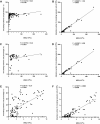Absolute Circulating Leukemic Cells as a Risk Factor for Early Bleeding Events in Patients with Non-High-Risk Acute Promyelocytic Leukemia
- PMID: 34045900
- PMCID: PMC8149285
- DOI: 10.2147/CMAR.S309138
Absolute Circulating Leukemic Cells as a Risk Factor for Early Bleeding Events in Patients with Non-High-Risk Acute Promyelocytic Leukemia
Abstract
Background: Hemorrhagic complications are the most common cause of early death in patients with APL and remain a major challenge in the management of APL. Early fatal bleeding events occur not only in high-risk but also in non-high-risk acute promyelocytic leukemia (APL) patients with normal or low WBC counts.
Objectives and methods: To demonstrate the role of the absolute number of circulating leukemic cells in early bleeding events in APL patients. Clinical and laboratory characteristics of 149 patients newly diagnosed with APL were obtained from medical records and retrospectively investigated.
Results: In this study, circulating absolute leukemic cells were positively correlated with the WBC count (r=0.9813, p<0.001) in all patients with APL, and importantly, they were strongly associated with significant bleeding events in non-high-risk patients. Multivariate logistic regression analysis showed that the absolute number of leukemia cells was an independent risk factor for significant bleeding events in APL patients. A cut-off value of 2.59×109/L for circulating leukemic cells to predict significant bleeding events in APL patients was obtained by ROC curve analysis. We further confirmed that the significant bleeding rate of patients with non-high-risk APL was statistically increased when the absolute number of circulating leukemic cells was ≥2.59×109/L.
Conclusion: Circulating leukemic cell content has great clinical value for predicting early bleeding events in APL patients, especially in non-high-risk APL.
Keywords: circulating leukemic cells; early fatal bleeding events; non-high-risk acute promyelocytic leukemia.
© 2021 Pei et al.
Conflict of interest statement
The authors report no conflicts of interest in this work.
Figures





Similar articles
-
Value of the FDP/FIB ratio in predicting early severe bleeding events in patients with newly diagnosed acute promyelocytic leukemia.Ann Hematol. 2023 Apr;102(4):787-794. doi: 10.1007/s00277-023-05122-8. Epub 2023 Feb 7. Ann Hematol. 2023. PMID: 36750485
-
[Correlation between D-Dimer/Fibrinogen Ratio and Bleeding in Patients with Newly Diagnosed Acute Promyelocytic Leukemia].Zhongguo Shi Yan Xue Ye Xue Za Zhi. 2023 Oct;31(5):1340-1344. doi: 10.19746/j.cnki.issn.1009-2137.2023.05.014. Zhongguo Shi Yan Xue Ye Xue Za Zhi. 2023. PMID: 37846682 Chinese.
-
Clinical bleeding events and laboratory coagulation profiles in acute promyelocytic leukemia.Eur J Haematol. 2012 Apr;88(4):321-8. doi: 10.1111/j.1600-0609.2011.01747.x. Epub 2012 Feb 2. Eur J Haematol. 2012. PMID: 22221178
-
[Correlation Analysis between Serum Fibronectin 3 Levels and Early Severe Bleeding in Patients with Newly Diagnosed Acute Promyelocytic Leukemia].Zhongguo Shi Yan Xue Ye Xue Za Zhi. 2024 Aug;32(4):1058-1062. doi: 10.19746/j.cnki.issn.1009-2137.2024.04.013. Zhongguo Shi Yan Xue Ye Xue Za Zhi. 2024. PMID: 39192398 Chinese.
-
Predictive factors of fatal bleeding in acute promyelocytic leukemia.Thromb Res. 2018 Apr;164 Suppl 1:S98-S102. doi: 10.1016/j.thromres.2018.01.038. Thromb Res. 2018. PMID: 29703492 Review.
Cited by
-
Acute promyelocytic leukemia with additional chromosome abnormalities in a patient positive for HIV: A case report and literature review.Oncol Lett. 2024 Apr 19;27(6):274. doi: 10.3892/ol.2024.14407. eCollection 2024 Jun. Oncol Lett. 2024. PMID: 38694571 Free PMC article.
-
The Coagulopathy of Acute Promyelocytic Leukemia: An Updated Review of Pathophysiology, Risk Stratification, and Clinical Management.Cancers (Basel). 2023 Jul 3;15(13):3477. doi: 10.3390/cancers15133477. Cancers (Basel). 2023. PMID: 37444587 Free PMC article. Review.
References
LinkOut - more resources
Full Text Sources
Other Literature Sources

